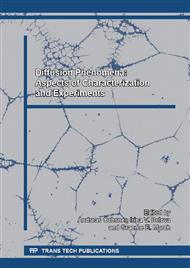[1]
G.Z. Gershuni and E.M. Zhukhovitskii: Convective Stability of Incompressible Fluids (Keter, Jerusalem 1976).
Google Scholar
[2]
A.G. Shashkov and T.N. Abramenko: Cross Effects in Gas Mixtures (Nauka i Tekhnika, Minsk 1976). (in Russian).
Google Scholar
[3]
T.N. Abramenko, A.F. Zolotukhina and E.A. Shashkov: Thermal Diffusion in gases (Nauka i Tekhnika, Minsk 1982). (in Russian).
Google Scholar
[4]
D. Joseph: Stability of Fluid Motions (Wiley, New York 1981).
Google Scholar
[5]
D. Villers and J.K. Platten: J. Nonequilib. Thermodyn. Vol. 9 (1984), p.131.
Google Scholar
[6]
Double-diffusive Convection, edited by A. Brandt and H.J.S. Fernando/ American Geophysical Union, Washington, USA (1995).
Google Scholar
[7]
J.S. Turner: Buoyancy Effects in Fluids (Cambridge University Press, UK 1979).
Google Scholar
[8]
S. Chen, J. Tӧlke and M. Krafczyk: Int. J. Heat and Mass Flow Vol. 31 (2010), p.217.
Google Scholar
[9]
N.V. Gnevanov and B.L. Smorodin: J. Appl. Mech. and Tech. Phys Vol. 47 (2) (2006), p.214.
Google Scholar
[10]
H.E. Huppert and J.S. Terner: J. Fluid Mech. Vol. 106 (1981), p.299.
Google Scholar
[11]
R.C. Paliwal and C.F. Chen: J. Fluid Mech. Vol. 98 (1980 a, b), p.775, 769.
Google Scholar
[12]
K. Kӧtter, M. Schmick and M. Markus: Nonlin. Phenom. in Complex Systems Vol. 4 (4) (2001), p.322.
Google Scholar
[13]
S. Chandrasekhar: Hydrodymanic and hydromagnetic stability (Claredon Press, Oxford 1961).
Google Scholar
[14]
R.S. Schechter, M.G. Velarde and J.K. Platten: Adv. Chem. Phys. Vol. 26 (1974), p.265.
Google Scholar
[15]
E. Crespo and M.G. Velarde: Int. J. Heat Mass Transfer Vol. 25 (1982), p.1451.
Google Scholar
[16]
D.T.G. Hurle and E. Jakeman: Phys. Letters Vol. 43 A (1973), p.127.
Google Scholar
[17]
D. Henry and B. Roux: J. Fluid Mech. Vol. 195 (1988), p.175.
Google Scholar
[18]
S. Rosenblat: J. Fluid Mech. Vol. 122 (1982), p.395.
Google Scholar
[19]
Yu.I. Zhavrin, N.D. Kossov, S.M. Belov and S.B. Tarasov: Zhurnal Tekh. Fiz. Vol. 54 (5) (1984), p.943.
Google Scholar
[20]
L. Miller and E.A. Mason: Phys. Fluids Vol. 9 (4) (1966), p.711.
Google Scholar
[21]
W. Merzkirch: Approaches in Flow Visualization. Trends in Optical Non-Destructive Testing and Inspection (Elsevier, Amsterdam 2000).
DOI: 10.1016/b978-008043020-1/50038-7
Google Scholar
[22]
S. Bretschneider: Properties of Gases and Liquids (Khimiya, Moscow 1966). (in Russian).
Google Scholar
[23]
R. Haase: Thermodynamik der irreversiblen Prozesse (Steinkopff, Darmstadt 1963; Mir, Moscow 1967).
Google Scholar
[24]
R. B . Bird, W.E. Stewart and E.N. Lightfoot: Transport Phenomena (New York: John Wiley & Sons, Inc. 2002).
Google Scholar
[25]
P. Dunlop and C.M. Bignell: J. Chem. Phys. Vol. 86 (1987), p.2922.
Google Scholar
[26]
Yu.I. Zhavrin, A.Z. Aitkozhaev, V.N. Kosov and S.A. Krasikov: Tech. Phys. Lett. Vol. 21 (3) (1995), p.206.
Google Scholar
[27]
V.N. Kosov, V.D. Seleznev and Yu.I. Zhavrin: Tech. Phys. Vol. 42 (10) (1997), p.1236.
Google Scholar
[28]
R. Taylor and R. Krishna: Multicomponent mass transfer (John Wiley & Sons, Inc., New York 1993).
Google Scholar
[29]
V.D. Seleznev and V.G. Smirnov: Zhurnal Tekh. Fiz. Vol. 51 (4) (1981), p.975.
Google Scholar
[30]
V.N. Kosov, O.V. Fedorenko and Yu.I. Zhavrin: Tech Phys. Vol. 59 (2014), p.482.
Google Scholar


